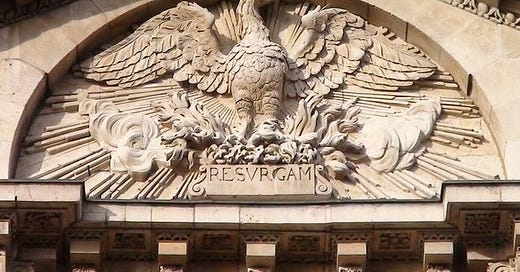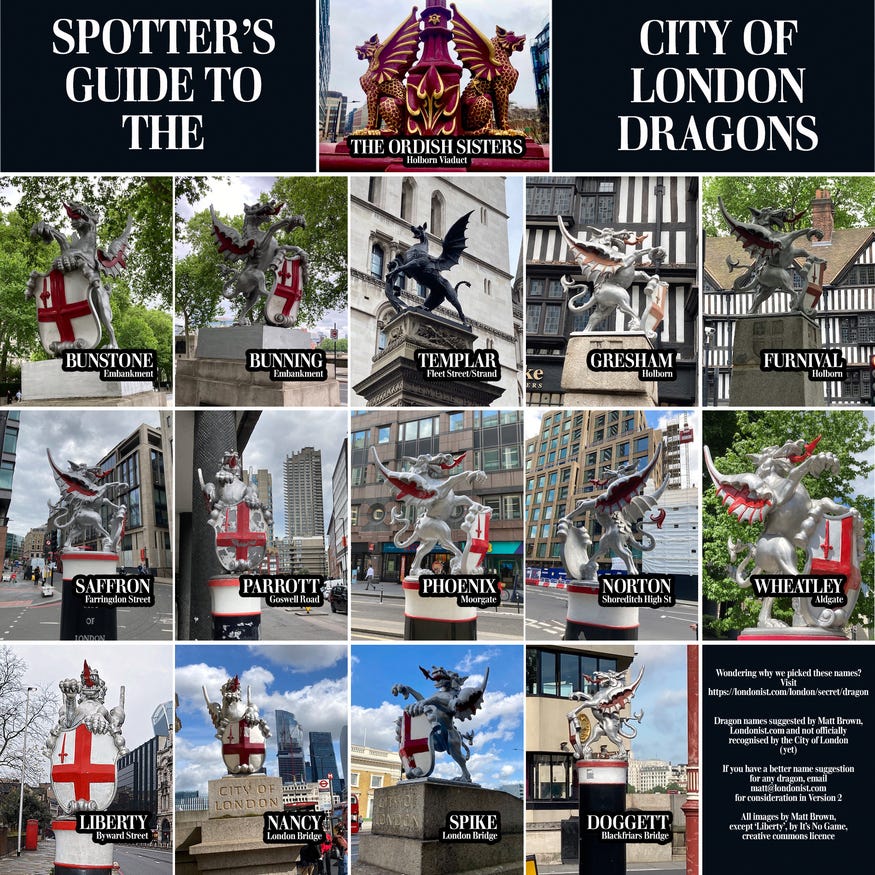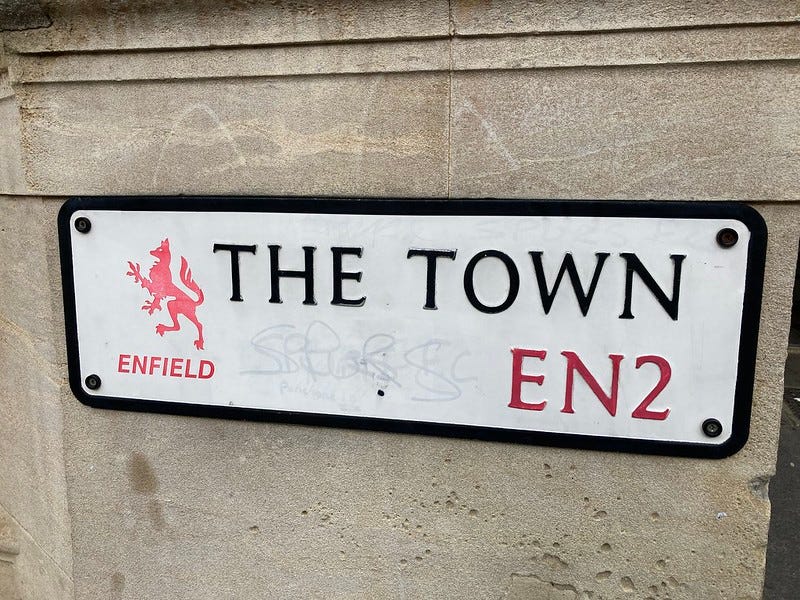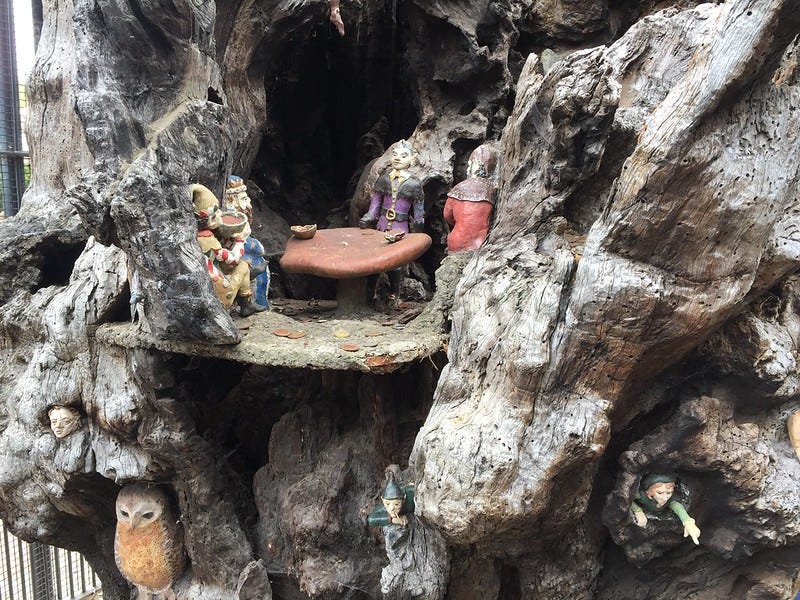The Mythical Creatures of London
Spotting dragons, mermaids and giants... with an historical twist.
Welcome to your Friday newsletter for paying subscribers, with a generous teaser for everyone else.
This week, fantastic beasts and where to find them. We’re talking dragons, fairies, griffins, minotaurs… Yes, it’s a slightly frivolous topic, but one that conceals plenty of history. Before that, a couple of notices and the History Radar…
📣📣 First a big thank you to everyone who’s signed up to this newsletter because, I am excited to reveal, we’ve now reached THIS MANY subscribers
I’m blown away by that. Thank you! And also for all the lovely emails people have been sending.
📣📣 Second, a quick reminder that we’re meeting for drinks in an historic pub (tbc) on Wednesday 11 September. This is for paying subscribers (and their plus-ones) only. If you’d like to join us for an historical chinwag, please email me on matt@londonist.com. Be lovely to see/meet a few of you.
History Radar
Upcoming events for those who enjoy London’s history.
🎻 MONDAY MATINEE: On 2 September, head to Handel Hendrix House in Mayfair for a matinee performance by the Portrait Players. They tackle works that Handel wrote for some of his favourite soloists, including cellist Andrea Caporale, oboeist Johann Ernst Galliard and singers Margherita Durastanti, Anna Maria la Strada, Élisabeth Duparc and John Beard. All played in the composer’s own home.
⬇️ BENEATH LONDON'S STREETS: I don’t normally list walking tours by individual guides here (there are simply too many), but Footprints of London guide Rob Smith is one of the best, and his tour beneath London's streets on 2 September sounds fascinating. Begin at Tower Hill station and visit a church crypt, the remains of London's largest tea warehouse, an underground market, bits of Roman London and what is probably London's deepest shop -- all open to the public, but you probably weren't aware of them before.
🫅🏼 VOYAGE AROUND THE QUEEN: On 5 September, The V&A hosts author Craig Brown to launch his new book, a biography of Queen Elizabeth II. A Voyage Around The Queen combines biography, essays, cultural histories and more, to paint a picture of the late monarch. You can watch in-person at the museum, or online via livestream.
⛪️ HERITAGE OPEN DAYS: The Heritage Open Days programme in London begins on 6 September. It sees churches, palaces, manor houses, cemeteries and water towers among the properties that invite the public inside for the occasion. Think of it as a sort-of warm-up for Open House the week after.
🤼♂️ OLYMPIC YEARS WALK: While the Paralympics are going on in Paris, learn about London's own Olympic history. Hammersmith BID offers a guided walk on 7 September, starting at Shepherd's Bush Market and focusing on when the 1908 Olympics took place in White City.
👸🏻🫅🏼🤴🏻👸🏻🫅🏼🤴🏻SIX LIVES: It’s your last chance to catch the National Portrait Gallery’s barnstorming exhibition, which features Tudor paintings by Hans Holbein the Younger and contemporary photography by Hiroshi Sugimoto. Six Lives chronicles the representation of Katherine of Aragon, Anne Boleyn, Jane Seymour, Anne of Cleves, Katherine Howard and Katherine Parr throughout history and popular culture. It finishes on 8 September.
📘 READ OF THE WEEK: Think Croydon is crap? Think again. Croydonopolis: A Journey to the Greatest City That Never Was waxes lyrical about London's most misunderstood town: archbishops, retail magnates, aviators, starchitects, record breakers, pop stars -- Croydon has produced the best of them, as this book proves. It publishes on 5 September and you can use the code CROYDON10 for a 10% discount here. (Disclaimer: in the interest of transparency, the book is by Londonist: Croydon Edit writer Will Noble.)
The Mythical Creatures of London
Here by dragons. And giants. And mermaids, minotaurs and pegasi. London is a living bestiary of mythological creatures. They pop up on flags, gateposts, sculptures and even our bollards.
Welcome to my cryptozoological guide to the capital, with historical notes on each monster.
Note: Museum stuff is not included (e.g. the centaurs on the Parthenon marbles); the list would become more tangled than a medusa in a cement mixer.
Dragons
Scaly beasts can be found all across London, but the Square Mile is a particularly notorious dragons’ lair. The fearsome creatures have been considered guardians of the City since at least 1609, when they first appeared on the City Shield. You will find them perching upon Holborn Viaduct, clinging to the corners of the Monument, propping up the roof of Leadenhall Market and, most famously, watching over the boundary roads.
What not many people know is that all of the 14 boundary dragons have names. Or, rather, they all have names according to me. They are such handsome beasts, and should not remain anonymous. Next time you’re walking around the City, say hello from me.
Enfields
“The Enfield,” Wikipedia informs me, “has the head of a fox, forelegs like an eagle's talons, the chest of a greyhound, the body of a lion, and the hindquarters and tail of a wolf. It is occasionally portrayed with wings.” This bizarre refugee from Frankenstein’s Zoo also happens to be the symbol of the London Borough of Enfield, which proudly appends the creature to its street signs.
The heraldic device is of medieval Irish origin, but nobody knows who originally came up with it, or what they were smoking. It’s name, the ‘Enfield’, is first attested in the 16th century and is thought (somehow) to have derived gradually from the older Gaelic name for the beast, Onchu.
Enfield in London, meanwhile, has no historic connection to the creature, but is ultimately named after an Anglo-Saxon family. The creature was placed upon Enfield District’s crest in 1946, and carried over onto the arms of the London Borough of Enfield in 1965.
Fairies (and gnomes and elves)
My eight-year-old daughter informed me yesterday that she no longer believes in fairies. This makes me sad. I will always remember fondly the times we spent hunting for “fairy doors” at the base of woodland trees (Barnet has a particularly fine collection).
These are recent additions to London’s fairy lore. But our city contains a much more venerable tree of “little people”. This is the Elfin Oak, which can be found close to the playground in Kensington Gardens. The dead stump belonged to a 900-year-old oak that originally grew in Richmond Park. It was transported to Kensington in 1928, where the illustrator Ivor Innes set to work, carving a miniature population of “fairies, gnomes, elves, imps, and pixies”. It is, I’m confident in asserting, London’s very best Grade II-listed fairy tree.








